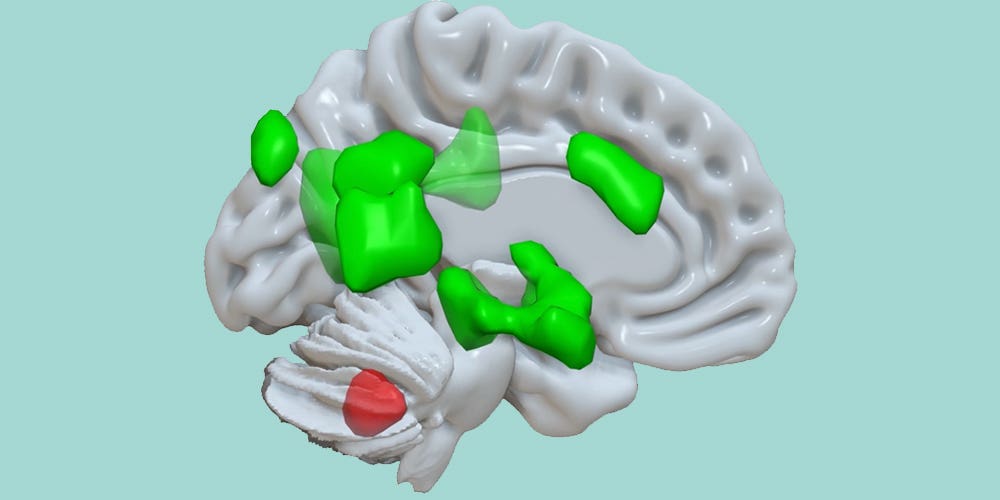Researchers discover a major new function of the cerebellum
Enhanced memory for emotional stimuli is crucial for survival, but it may also contribute to the development of fear-related disorders.

[Oct 14, 2022: Dominique de Quervain, University of Basel]
The cerebellum (activation in red) connects with different areas of the cerebrum (activations in green) to enhance the storage of emotional information. (CREDIT: MCN, University of Basel)
Enhanced memory for emotional stimuli is crucial for survival, but it may also contribute to the development and maintenance of fear-related disorders in case of highly aversive experiences. This large-scale functional brain imaging study identified the cerebellum and cerebellar–cerebral connections involved in the phenomenon of superior memory for emotionally arousing visual information.
The findings expand knowledge on the role of the cerebellum in complex cognitive and emotional processes and may be relevant for the understanding of psychiatric disorders with aberrant emotional circuitry, such as posttraumatic stress disorder or autism spectrum disorder.
The cerebellum is known primarily for regulation of movement. Researchers at the University of Basel have now discovered that the cerebellum also plays an important role in remembering emotional experiences. The study appears in the journal PNAS.
Both positive and negative emotional experiences are stored particularly well in memory. This phenomenon is important to our survival, since we need to remember dangerous situations in order to avoid them in the future. Previous studies have shown that a brain structure called the amygdala, which is important in the processing of emotions, plays a central role in this phenomenon. Emotions activate the amygdala, which in turn facilitates the storage of information in various areas of the cerebrum.
Related Stories
The current research, led by Professor Dominique de Quervain and Professor Andreas Papassotiropoulos at the University of Basel, investigates the role of the cerebellum in storing emotional experiences. In a large-scale study, the researchers showed 1,418 participants emotional and neutral images and recorded the subjects’ brain activity using magnetic resonance imaging.
In a memory test conducted later, the positive and negative images were remembered by the participants much better than the neutral images. The improved storage of emotional images was linked with an increase in brain activity in the areas of the cerebrum already known to play a part. However, the team also identified increased activity in the cerebellum.
The cerebellum in communication with the cerebrum
The researchers were also able to demonstrate that the cerebellum shows stronger communication with various areas of the cerebrum during the process of enhanced storage of the emotional images.
Clusters showing an increased activation for enhanced emotional memory encoding within the discovery sample. Clusters span voxels significantly activated during enhanced emotional memory encoding (Pwhole-brain-FWE-corrected
It receives information from the cingulate gyrus – a region of the brain that is important in the perception and evaluation of feelings. Furthermore, the cerebellum sends out signals to various regions of the brain, including the amygdala and hippocampus. The latter plays a central role in memory storage.
“These results indicate that the cerebellum is an integral component of a network that is responsible for the improved storage of emotional information,” says de Quervain.
The cerebellum (red) and different areas of the cerebrum (green) interact to enhance the storage of emotional information. (CREDIT: MCN, University of Basel)
Although an improved memory for emotional events is a crucial mechanism for survival, it does have its downsides: in the case of very negative experiences, it can lead to recurring anxiety.
These findings expand knowledge about the role of the cerebellum in complex cognitive and emotional processes and may be relevant for the understanding of psychiatric disorders with aberrant emotional circuitry, such as PTSD or autism spectrum disorder.
Note: Materials provided above by University of Basel. Content may be edited for style and length.
Like these kind of feel good stories? Get the Brighter Side of News' newsletter.



